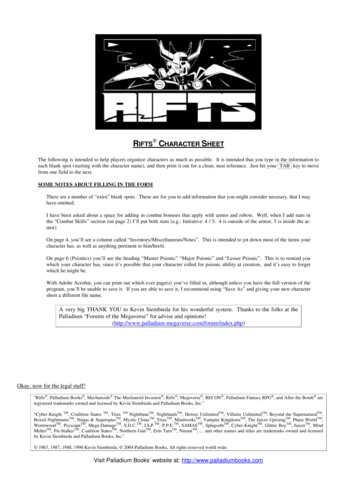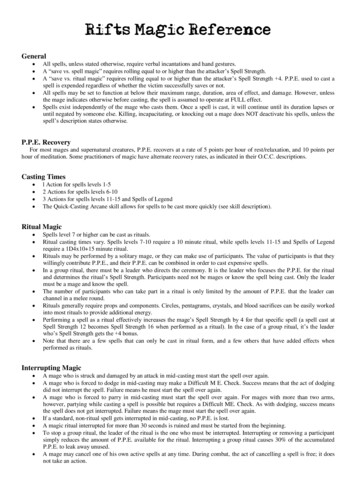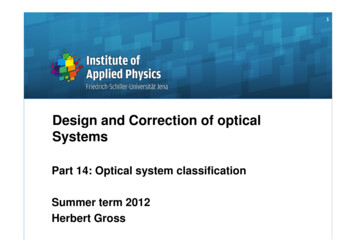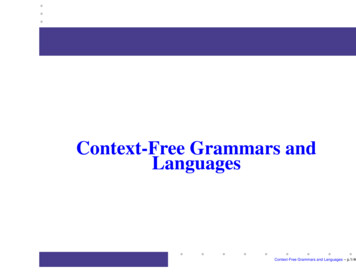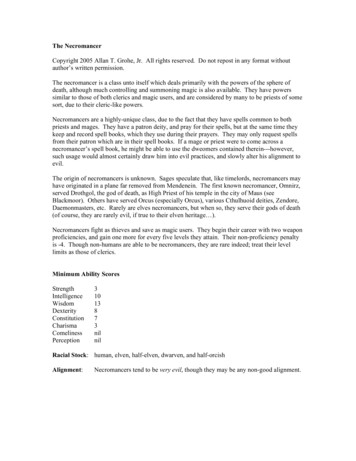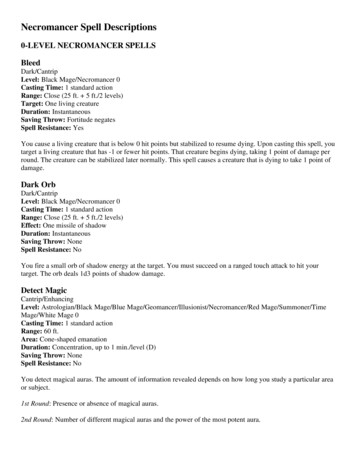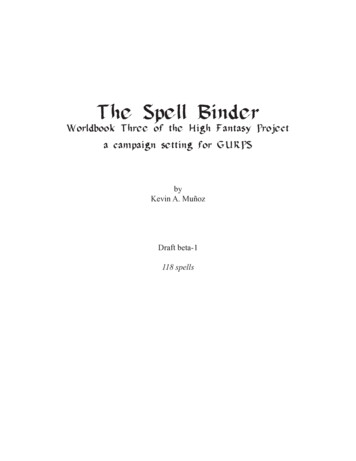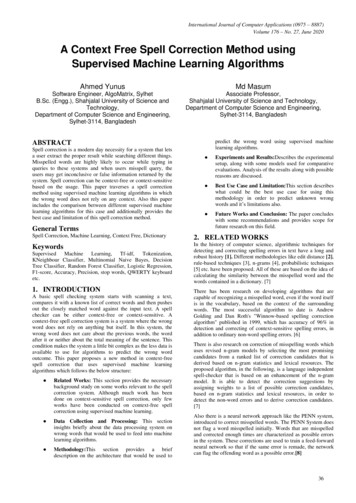
Transcription
International Journal of Computer Applications (0975 – 8887)Volume 176 – No. 27, June 2020A Context Free Spell Correction Method usingSupervised Machine Learning AlgorithmsAhmed YunusMd MasumSoftware Engineer, AlgoMatrix, SylhetB.Sc. (Engg.), Shahjalal University of Science andTechnology,Department of Computer Science and Engineering,Sylhet-3114, BangladeshAssociate Professor,Shahjalal University of Science and Technology,Department of Computer Science and Engineering,Sylhet-3114, Bangladeshpredict the wrong word using supervised machinelearning algorithms.ABSTRACTSpell correction is a modern day necessity for a system that letsa user extract the proper result while searching different things.Misspelled words are highly likely to occur while typing inqueries to these systems and when users misspell query, theusers may get inconclusive or false information returned by thesystem. Spell correction can be context-free or context-sensitivebased on the usage. This paper traverses a spell correctionmethod using supervised machine learning algorithms in whichthe wrong word does not rely on any context. Also this paperincludes the comparison between different supervised machinelearning algorithms for this case and additionally provides thebest case and limitation of this spell correction method.General Terms Experiments and Results:Describes the experimentalsetup, along with some models used for comparativeevaluations. Analysis of the results along with possiblereasons are discussed. Best Use Case and Limitation:This section describeswhat could be the best use case for using thismethodology in order to predict unknown wrongwords and it‟s limitations also. Future Works and Conclusion: The paper concludeswith some recommendations and provides scope forfuture research on this field.Spell Correction, Machine Learning, Context Free, Dictionary2. RELATED WORKSKeywordsIn the history of computer science, algorithmic techniques fordetecting and correcting spelling errors in text have a long androbust history [1]. Different methodologies like edit distance [2],rule-based techniques [3], n-grams [4], probabilistic techniques[5] etc. have been proposed. All of these are based on the idea ofcalculating the similarity between the misspelled word and thewords contained in a dictionary. Neighbour Classifier, Multinomial Naive Bayes, DecisionTree Classifier, Random Forest Classifier, Logistic Regression,F1-score, Accuracy, Precision, stop words, QWERTY keyboardetc.1. INTRODUCTIONA basic spell checking system starts with scanning a text,compares it with a known list of correct words and then pushesout the closely matched word against the input text. A spellchecker can be either context-free or context-sensitive. Acontext-free spell correction system is a system where the wrongword does not rely on anything but itself. In this system, thewrong word does not care about the previous words, the wordafter it or neither about the total meaning of the sentence. Thiscondition makes the system a little bit complex as the less data isavailable to use for algorithms to predict the wrong wordoutcome. This paper proposes a new method in context-freespell correction that uses supervised machine learningalgorithms which follows the below structure: Related Works: This section provides the necessarybackground study on some works relevant to the spellcorrection system. Although much work has beendone on context-sensitive spell correction, only fewworks have been conducted on context-free spellcorrection using supervised machine learning. Data Collection and Processing: This sectioninsights briefly about the data processing system onwrong words that would be used to feed into machinelearning algorithms. Methodology:This section provides a briefdescription on the architecture that would be used toThere has been research on developing algorithms that arecapable of recognizing a misspelled word, even if the word itselfis in the vocabulary, based on the context of the surroundingwords. The most successful algorithm to date is AndrewGolding and Dan Roth's "Winnow-based spelling correctionalgorithm" published in 1999, which has accuracy of 96% indetection and correcting of context-sensitive spelling errors, inaddition to ordinary non-word spelling errors. [6]There is also research on correction of misspelling words whichuses revised n-gram models by selecting the most promisingcandidates from a ranked list of correction candidates that isderived based on n-gram statistics and lexical resources. Theproposed algorithm, in the following, is a language independentspell-checker that is based on an enhancement of the n-grammodel. It is able to detect the correction suggestions byassigning weights to a list of possible correction candidates,based on n-gram statistics and lexical resources, in order todetect the non-word errors and to derive correction candidates.[7]Also there is a neural network approach like the PENN system,introduced to correct misspelled words. The PENN System doesnot flag a word misspelled initially. Words that are misspelledand corrected enough times are characterized as possible errorsin the system. These corrections are used to train a feed-forwardneural network so that if the same error is remade, the networkcan flag the offending word as a possible error.[8]36
International Journal of Computer Applications (0975 – 8887)Volume 176 – No. 27, June 2020There are numerous projects available online on spellingcorrection using neural nets. These are also context-sensitive.Kunal Bhashkar deployed his spell checker system usingTensorflow, Sequence to Sequence Model, Bi-directional LSTMetc. [10] This is just one of many systems available online.So a very little has been done on context-free spell correctionusing supervised machine learning algorithms. But a notablework has been done using supervised learning on Arabicspelling correction. The system used Naive-Bayes classifier withpython NLTK‟s implementation to find out which one is themost likely to be the correction for the incorrect word. [9]This paper introduces a new method that will convert a wrongword to a differently customized wrong word and feed thesedata to traditional supervised machine learning algorithms topredict the wrong data. For achieving this task cRegression will be used and we will compare the finaloutcomes using different measurement scales.the user might completely forget to type this letter. Figure1 shows a keyboard mapping where there is possibility ofchanging the left side letter to right side values. These areselected mostly based on the adjacency of characters in theQWERTY keyboard. So to generate wrong words, theprogram will traverse the words from start to the length ofthe correct word, pick a single letter, and replace it with theright side values one by one and thus generate a wrongword. An example is that a word is „come‟. So „m‟ is thethird letter. „m‟ letter can be mistyped with „n‟, „k‟, „mm‟or blanks. So from „come‟ word‟s third letter „m‟, 4 wrongwords can be generated and they are: „cone‟, „coke‟,„comme‟ and „coe‟. So this is how the wrong words list canbe generated programmatically.3. DATA COLLECTION ANDPROCESSING:The proposed methodology that will be discussed through thispaper can be applied to any language based on the wrong andcorrect words. But we will focus on English language as aconvenient solution. English comprises more than a millionwords, 171,476 words that are in current use and 20,000-30,000words used by each individual person [11]. There are availablesources to collect English words but the problem relies with thewrong words list against a correct word. The wrong word heremeans that this is occurred due to spelling mistakes.To start with, the first main task is to gather correct words fromdifferent sources. The first source is to take 1000 most commonwords in English [12]. Then we focused on most searched itemson Amazon [13]. We also collected random English words forexample brand names, product names and different vegetable,fruit names as our data. It is to be said, these selections arecompletely random and one can choose any English words theytend to use for the proposed model. Upon collecting this data,we have filtered and made a custom data set of 1000 Englishwords that comprises different verbs, nouns, adjectives etc. Thewords that do not exceed the length of 3 are ignored in thisdataset as those are not highly like to be misspelled.The next task starts with fetching the wrong words that tend tobe occurred by a user against a correct word. As we haveselected random English words, it is quite difficult to get a list ofwrong words against a single correct word. So we have takenanother approach where we make wrong wordsprogrammatically. These methods are followed to prepare thewrong word dataset: Swap letter: Any two letters are being swapped in a wordto make a wrong word of that correct word. Add a letter: Adds a new random letter in a correct wordto convert it to a wrong word. Keyboard character mapping: As we are working withEnglish language, to input any queries to a system, usersuse a QWERTY keyboard where the layout of thecharacters in the QWERTY keyboard leads a user tomisspell a word. Based on this idea, a correct word cangenerate multiple wrong words. For example, while typingthe letter „e‟, a user may mistakenly type „r‟ or „w‟ as theseare adjacent characters of „e‟ in the QWERTY keyboard orFigure 1: Keyboard mapping for possible wrong typo for acorrect letter in a word.Remove two letters: Sometimes a user can miss two letters in aword. So this can be a candidate for generating wrong wordsagainst a correct word.It is to be noted, the first letter of a correct word is unchanged inevery wrong letter that is being generated from a correct word.Following the rules mentioned above, we could generate morethan 50 wrong words from one single correct word which isenough to feed into supervised machine learning algorithms toverify our methodology. In our case, from 1000 correct words,we have generated about 44000 wrong words as train and testdata. For example a word ‘grapefruit’, we could have generatedthese wrong words:Table 1: Wrong words of word pefruitgrapefruyt37
International Journal of Computer Applications (0975 – 8887)Volume 176 – No. 27, June 2020perform both tokenization and feature extraction text data. Wordcounts are a good starting point, but are very basic. One issuewith simple counts is that some words like “the” will appearmany times and their large counts will not be very meaningful inthe encoded vectors. An alternative is to calculate wordfrequencies, and by far the most popular method is called Tf-idf.This is an acronym that stands for “Term Frequency – InverseDocument” Frequency which are the components of theresulting scores assigned to each word. Without going into themath, Tf-idf are word frequency scores that try to highlightwords that are more interesting, e.g. frequent in a document butnot across documents iIn CBT, the whole word is divided into characters and all thesecharacters are fed as a wrong word against a correct word.Table-2 depicts this idea.grapefriitgapefuiTable-2: CBT pefreuiSupervised machine learning algorithms use text classificationto predict the wrong words. As this is a supervised system, thetrain data must be labelled first. In our case, we have alreadyselected 1000 correct words for this system. To be noted, correctwords can be any dictionary of words selected by a humaninterpreter and this system will work according to thatdictionary. In section 3, we have discussed how to generatewrong words from one single correct word and to conduct ourresearch, we have generated about 44000 wrong words for 1000correct words.The next phase is to prepare the data to be fed for supervisedmachine learning algorithms. This is the most crucial part of thispaper as the success of this proposed method heavily depends onthe structure of input data rather than the algorithms. We haveintroduced three types of input as wrong words against a correctword that are to be fed into algorithms to predict an unknownwrong word. We have introduced three special terms here: WordBased Tokenization (WBT), Character Based Tokenization(CBT) and Advance Character Based Tokenization (ACBT).In WBT, the whole wrong word is identified as the wrong word.For example: the wrong word of „grapefruit‟ is „gapefruit‟ andthis „gapefruit‟ will be directly identified as the wrong word. Inour case, the Table-1 shows all the wrong words for the correctword „grapefruit‟. Supervised Algorithms here learn themapping of input to output, and in this case wrong words to acorrect word. So every wrong word is a feature and algorithmstry to find patterns to make classification based on the inputs.The problem is that the inputs are all different and it causes agreat number of features, leading to no match with one feature toanother that makes the classification very hard.Correct rapefriitgrapefriit.4. METHODOLOGY.Text data requires special preparation before starting to use it forpredictive modeling. The text must be parsed to remove words,called tokenization. Then the words need to be encoded asintegers or floating point values for use as input to a machinelearning algorithm, called feature extraction (or vectorization).The scikit-learn library in Python offers easy-to-use tools to.In the case of WBT, there is actually no pattern among wrongwords as inputs. But in CBT, we can clearly find out that there is38
International Journal of Computer Applications (0975 – 8887)Volume 176 – No. 27, June 2020a pattern between „g a p e f r u i i t‟ and „g r a p e f r i i t‟. Sowhat actually CBT does is, it breaks the characters and makes asentence consisting of characters. So it helps the algorithms tofind the patterns among the wrong words to make aclassification. The wrong words must be vectored and for thisreason Tf-idf has been chosen. But the above mentioned methodalso creates a problem in Tf-idf. As these are broken intocharacters, Tf-idf recognizes them as stop words, which meansthese are commonly used words (such as “the”, “a”, “an”, “in”)that a search engine has been programmed to ignore [15]. AsCBT breaks the word into individual letters, Tf-idf recognizesthem as stop words for which it removes entire data. So „g a p ef r u i i t‟ cannot be fed into the algorithms. One way toovercome this is to append the same letter with itself so that theletters would become a word and Tf-idf would not recognizethose words as stop words. This appending would not affect theresults as data dimensions will be the same across all train, testand new unknown wrong words. According to this rule, CBTwill have a new shape that is shown in the next table.Table-3: Final CBT transformationCorrect wordgrapefruitWBTgapefruitii i8 tt t9grapefruitgrapefriitgg rr aa ppee ff rr ii iittgg g0 rr r1aa a2 pp p3ee e4 ff f5rr r6 ii i7 iii8 tt t9.5. EXPERIMENTS AND RESULTSSo we have prepared three kinds of inputs to test if supervisedmachine learning algorithms can predict unknown wrong wordsthat happen due to spelling mistakes. We have selected multiplealgorithms which are given below:KNeighborsClassifierCBTgg aa pp ee ff rruu ii ii ttgrapefruitgrapefriitgg rr aa pp ee ffrr ii ii tt.In this method, if words consist of English letters only, featuresare reduced dramatically which is only 26 and they are „aa‟,„bb‟, „cc‟, „dd‟, „ee‟, „ff‟, „gg‟, „hh‟, „ii‟, „jj‟, „kk‟, „ll‟, „mm‟,„nn‟, „oo‟, „pp‟, „qq‟, „rr‟, „ss‟, „tt‟, „uu‟, „vv‟, „ww‟, „xx‟, „yy‟and „zz‟. As all wrong words are now made of these features,supervised machine learning will find a pattern among differentwrong words for one class and according to that, the algorithmswill make a prediction on new unknown wrong words to make aprediction from the dictionary.To increase the number of features, ACBT has been introduced.ACBT adds up character positions to make this more uniqueamong the wrong words of a correct word. Here the wrong wordis „gapefruit‟ where g‟s position is 0, a‟s position is 1 and so on(assuming this „gapefruit‟ is an array of characters). So if we addthese positions, this might help classifiers to train, test andpredict data with better accuracy. Table-4 shows ACBTformation. Multinomial Naive Bayes DecisionTreeClassifier RandomForestClassifier LogisticRegressionWe have selected 1000 correct words that are defined by humaninterpreters and generated 44277 wrong words using differentmethods stated in Section 3. We splitted data into 30% as ourtest data and 70% as our train data. We fed our data intoalgorithms and the results we have found are mentioned belowin the tables.Table-5: Feature InformationMethod NameTotal FeaturesWBT32837CBT26ACBT604Table-6: Mean and Standard Deviation (STD) InformationModel \MethodWBTCBTACBTKNeighborsClassifierMean :0.043138Mean :0.763191Mean :0.892916STD :0.004887STD :0.006133STD :0.007697Mean :0.141836Mean :0.507213Mean :0.667203STD :0.007306STD :0.009165STD :0.006328Table-4: ACBT ruitgg aa pp eeff rr uu ii iittgg g0 aa a1pp p2 ee e3ff f4 rr r5uu u6 ii i7Multinomial NaiveBayes39
International Journal of Computer Applications (0975 – 8887)Volume 176 – No. 27, June gisticRegressionMean :0.328743Mean :0.682109Mean :0.808221STD :0.011555STD :0.010430STD :0.007296Mean :0.204394Mean :0.719149Mean :0.826064STD :0.007309STD :0.007349STD :0.004893Mean :0.185135Mean :0.657886Mean :0.829931STD :0.007029STD :0.007435STD :0.005252Table-7: Accuracy, F1-Score,Model \MethodKNeighborsClassifierMultinomial fierLogisticRegressionWBTCBTACBTAccuracy:12.78 %Accuracy:77.30 %Accuracy:90.14 56Support:8856Support:8856Accuracy:15.50 %Accuracy:51.88 %Accuracy:67.56 56Support:8856Support:8856Accuracy:19.73 %Accuracy:59.26 %Accuracy:82.46 45Support:8856Support:8856Accuracy:20.71 %Accuracy:72.73 19.58 %Accuracy:66.82 00.67Support:8854Support:8856Support:8856We have used a completely unknown wrong word to predict thecorrect word. The unknown word is „gapeefruutttt‟. The result isstated below:Table-8: Prediction on unknown word ‘gapeefruutttt’Model itgrapefruitMultinomial tgrapefruitFrom Table-6, Table-7 and Table-8, we can clearly understandhow CBT and ACBT outperforms the WBT method. It isexpected as the features extracted via WBT method does nothelp the classifiers to predict unknown words. Also, it can beclearly understood that adding position feature in ACBTincreases Accuracy, F1-Score and also predicts much better thanCBT and WBT.6. BEST USE CASE AND LIMITATIONThe mentioned method works greatly if the dictionary is customdefined by a human interpreter. For example if this system isdeployed behind an ecommerce system, then there would bewords consisting of different brand names, product names etc.which will not have the same pattern of characters amongthemselves. If the words have the same patterns e.g. „research‟and „search‟ in the dictionary, this system might not predict thewrong word to the correct word properly. This would work finein a system where the letters are from English alphabets but thewords might be different from English language dictionaries forexample in a medical or pharmaceutical company.40
International Journal of Computer Applications (0975 – 8887)Volume 176 – No. 27, June 20207. FUTURE WORKS AND CONCLUSIONThere are many scopes to improve the research. The researchwas conducted on 1000 correct words only which can beextended using all the English language‟s vocabulary to find outthe accuracy. Also this method has the opportunity to be usedother than English and that is a huge area of research. Also thereis an opportunity to use Artificial Neural Network for thismethod and look at how that system performs. And lastly wehope to see the implementation of this method in various areaslike in searching systems of websites in the future.8. REFERENCES[1] K. Kukich, “Techniques for automatically correcting wordsin text,” ACM Computing Surveys, 24(4), 377–439, 1992.[2] R. A. Wagner and M. J. Fisher, “The string to stringcorrection problem,” Journal of Assoc. Comp. Mach.,21(1):168-173, 1974[6] Golding, Andrew R.; Roth, Dan (1999). "Journal Article".Machine Learning. SpringerLink. 34: 107–130.doi:10.1023/A:1007545901558[7] Revised N-Gram based Automatic Spelling CorrectionTool to Improve Retrieval Effectiveness,December 2009,DOI: 10.17562/PB-40-6[8] Personalized Spell Checking using Neural Networks byTyler Garaas, Mei Xiao, and Marc Pomplun[9] Arabic Spelling Correction using Supervised Learning,September 2014, DOI: 10.3115/v1/W14-3615[10] hattention-flow-works-in-366fabcc7a2f[11] wordsenglish-language/[3] E. J. Yannakoudakis and D. Fawthrop, “An intelligentspelling error corrector,” Information Processing andManagement, 19:1, 101-108,1983.[12] ocabulary/top-1000-words/[4] Jin-ming Zhan, Xiaolong Mou, Shuqing Li, Ditang Fang,“A Language Model in a Large-Vocabulary SpeechRecognition System,” in Proc. Of Int. Conf. ICSLP98,Sydney, Australia, 1998.[14] tamachine-learning-scikit-learn/[5] K. Church and W. A. Gale, “Probability scoring forspelling correction,”Statistics and Computing, Vol. 1, No.1, pp. 93–103, 1991.IJCATM : www.ijcaonline.org[13] https://ahrefs.com/blog/top-amazon-searches/[15] nltkpython/41
A basic spell checking system starts with scanning a text, compares it with a known list of correct words and then pushes out the closely matched word against the input text. A spell checker can be either context-free or context-sensitive. A context-free spell correction system is a system where the wrong
